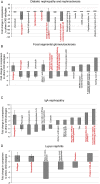Noninvasive diagnosis of chronic kidney diseases using urinary proteome analysis
- PMID: 27984204
- PMCID: PMC5837301
- DOI: 10.1093/ndt/gfw337
Noninvasive diagnosis of chronic kidney diseases using urinary proteome analysis
Abstract
Background: In spite of its invasive nature and risks, kidney biopsy is currently required for precise diagnosis of many chronic kidney diseases (CKDs). Here, we explored the hypothesis that analysis of the urinary proteome can discriminate different types of CKD irrespective of the underlying mechanism of disease.
Methods: We used data from the proteome analyses of 1180 urine samples from patients with different types of CKD, generated by capillary electrophoresis coupled to mass spectrometry. A set of 706 samples served as the discovery cohort, and 474 samples were used for independent validation. For each CKD type, peptide biomarkers were defined using statistical analysis adjusted for multiple testing. Potential biomarkers of statistical significance were combined in support vector machine (SVM)-based classifiers.
Results: For seven different types of CKD, several potential urinary biomarker peptides (ranging from 116 to 619 peptides) were defined and combined into SVM-based classifiers specific for each CKD. These classifiers were validated in an independent cohort and showed good to excellent accuracy for discrimination of one CKD type from the others (area under the receiver operating characteristic curve ranged from 0.77 to 0.95). Sequence analysis of the biomarkers provided further information that may clarify the underlying pathophysiology.
Conclusions: Our data indicate that urinary proteome analysis has the potential to identify various types of CKD defined by pathological assessment of renal biopsies and current clinical practice in general. Moreover, these approaches may provide information to model molecular changes per CKD.
Keywords: biomarkers; chronic kidney disease; peptides; proteome analysis; urine.
© The Author 2016. Published by Oxford University Press on behalf of ERA-EDTA. All rights reserved.
Figures



References
-
- K/DOQI clinical practice guidelines for chronic kidney disease: evaluation, classification, and stratification. Am J Kidney Dis 2002; 39: S1–266 - PubMed
-
- Jha V, Garcia-Garcia G, Iseki K. et al. Chronic kidney disease: global dimension and perspectives. Lancet 2013; 382: 260–272 - PubMed
-
- Eckardt KU, Coresh J, Devuyst O. et al. Evolving importance of kidney disease: from subspecialty to global health burden. Lancet 2013 - PubMed
-
- Freedman BI, Sedor JR. Hypertension-associated kidney disease: perhaps no more. J Am Soc Nephrol 2008; 19: 2047–2051 - PubMed
MeSH terms
Substances
Grants and funding
LinkOut - more resources
Full Text Sources
Other Literature Sources
Medical

